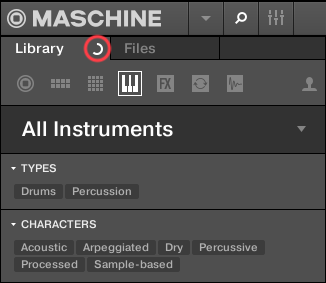

loads of buttons, RGB leds, endless knobs and two 256圆4 monochrome displays! But how to use it? No, I wasn' t going to tear it apart and cannibalize some pieces, I had to find a less "intrusive" solution. All of a sudden that Maschine MK2 laying on my desk started to look even sexier. who knows, if the next Berlin winter is long enough I might also spend time designing some hardware).Īnyways.
Reset maschine library software#
wait a second! Did I really want to build a dedicated hardware control surface from the ground up? Of course it would have been great and rewarding, but would have required quite some time, and I wanted to be rather focused on the sequencing engine and the software features (well. Then I decided that it was time to build a simple CV/gate sequencer: I took inspiration from some nice and interesting open source projects ( MIDIAlf with CV board and Sonic Potions LXR, to name a couple) and put together some prototypes using breadboards and Arduino. Of course I was already having fun with a CVPal and my laptop, but somehow it felt weird having to use a mouse to shape my sequences, when all the sounds were created and processed on my modular synthesizer. I've built oscillators, filters, LFOs, VCAs, a bucket brigade delay unit, yet there was something very important missing: I needed an hardware sequencer! Since a few months, though, I've been more and more involved into modular synthesis, and the amount of eurorack modules in my case has been slowly but constantly growing. I've been a Maschine user for almost two years now, and it's well integrated in my usual setup. The final result is a hardware shield for the Raspberry Pi Zero board and the necessary software and scripts running on the Zero itself and providing real-time conversion from Ableton Link to eurorack-friendly clock and reset signals. When the PCB finally arrived, I put everything together and spent some more time fine-tuning and optimizing here and there. Having abandoned the "bare metal" approach, the next natural candidate became a Raspberry Pi board: I had a Zero lying around and decided to use it to build the first prototype, mainly because of the power requirements and the form factor.Ī couple of weekends later I had a working prototype and decided to design and order a PCB, which I only received almost two months later (thanks, Custom Office.). I made the first attempt with a Teensy 3.2 board and a a WIZ820io ethernet module, but due to some of the dependencies of Ableton Link, this approach proved too complex, as it would have required a complete rewrite of the low-level networking functionality. When Ableton published the Link source code, I started experimenting with it and decided to explore the feasibility of a hardware Link-to-clock converter.


 0 kommentar(er)
0 kommentar(er)
